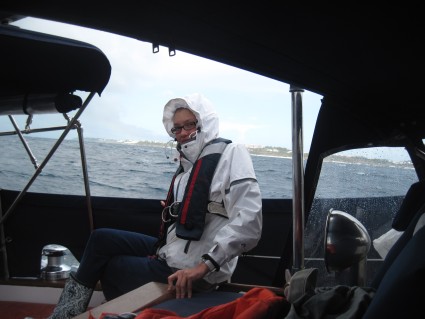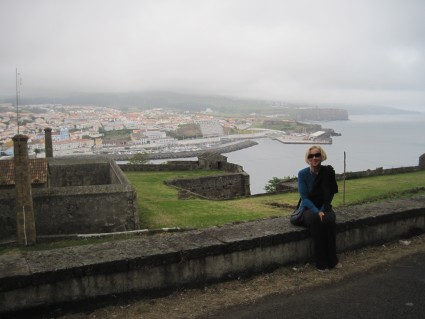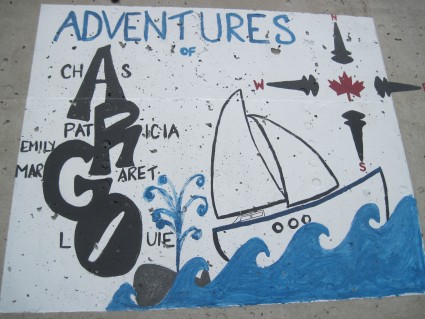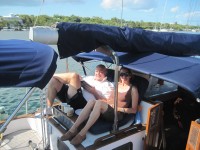The Travels of Argo
08 April 2011 | Late March - Stratford
04 April 2011 | Early March - Titusville
03 April 2011 | Titusville - Late February
01 April 2011 | Titusville
29 March 2011 | Fort Pierce to Titusville
29 March 2011 | Fort Pierce
28 March 2011 | Green Turtle Cay
28 March 2011 | Black Sound
27 March 2011 | Abaco Yacht Services
26 March 2011 | Atlantic - Off Little Bahama Bank
26 March 2011 | Titusville
Back in Azores - Nov. 2011
17 December 2011

Louie and I spent about four weeks in Angra. The time was mostly spent getting Argo back in shape after the Atlantic crossing. The boat is on the hard which made maintenance a little easier. We will return in March to do a tour of the surrounding islands.
Atlantic Review - May 2011
16 December 2011 | Part 1

Here's my analysis of our Atlantic crossing
Route: We departed from Titusville in Florida. The idea was to get into the Atlantic and follow the Gulf stream to about 35 north and then sail toward the Azores. Our back-up was to follow the stream as long as southerly winds held and alter course to Bermuda if the weather changed, especially if the winds moved to the north. We ended riding the Stream for about 2 days but altered course to Bermuda when northly type gale force winds made the Gulf Stream very uncomfortable. Our route to the Azores was meant to be a middle route following the GPS on a Great Circle type of direction. This proved to be the best for 2011 as there were no westerly winds further north and the southern route had intense low pressure cells that played havoc with the yachts that took this route. We took 7 days to Bermuda with one night moving very slowly to avoid approaching Bermuda during the evening. We went under Bermuda as the reefs on the west coast made me jittery. It was about 13 days to Flores which included 2 days of motoring through the high that often surrounds the islands.
Boat: The only breakage was a torn mainsail above the first reef points. This was repaired in St. George. The leech of the main became frayed and was repaired at sea. Argo is a heavier displacement type sailboat that handled the rough conditions to Burmuda very well and did surprisingly well in the lighter conditions to the Azores. We took water into the cockpit on one occasion and was glad of the large scuppers and smaller type steering area. The inside steering station was used very little as I wanted the watch in the cockpit where it is easier to observe the surrounding environment. We have a cutter rig and made extensive use of the stay sail and flew the 110 genny for much of the time. I was glad that I decided to remove the 150 from the roller-furling. The staysail and 110 gave the diversity I wanted. I wish there was a third set of reef-points on the main. Making use of our storm tri-sail would have been a last ditch effort as hanking it on in large seas would have been interesting. The dinghy was put on the davits for the first leg and on the foredeck for the 2nd and 3rd leg. When on the davits a large wave broke over the boat filling the cockpit and dinghy but both drained well. Although it was a worry to have the dink on the back it made working by the mast more difficult when lashed to the foredeck.
Provisions: Argo has plenty of storage room so we had enough food at the end of the trip to last another 3000 miles. The boat has 3 fresh water tanks with about 250 gallons of storage. WE filled one tank of about 125 gallons for cleaning and the other two tanks will filled with one gallon fresh water jugs and other liquids for consumption. We still had about 10 gallons of fresh water for cleaning, 12 jugs of water and 2 cases of pop when we reached Angra.
Engine: WE put on over a hundred hours of motoring by the time we reached Angra. Fuel was taken on in Bermuda. We consume about 11/2 gallons per hour at 6 knots and had about 15 gallons on arrival. Argo can store over 300 gallons of fuel but was never filled past the 3/4 mark. We changed the fuel filters in Burmuda and Flores which was required and the oil was changed in Angra. Engine was reliable.
Energy: Solar panels that produced about 10 amps under ideal conditions were installed in Florida. Worked very well. Our Honda generator was never used and the motoring we did provided the remaining power. Navigation lights and refrigeration were the main draws as we were careful about cabin lights and other power uses. We have 4 larger type deep discharge batteries.
Weather and route: May & JUne are the months to go west to east. The important decision is when to depart during this time and that comes down to a weather window. A satellite phone was used to make contact with Jeff and Alexander regarding weather while on route while they used Passage Weather site as main source of information. This worked well. There is a weather router that is used by many that cross, getting information via their SSB. WE have an SSB and listened to what he said but in the end I didn't follow his advice. He was telling people to head south from Bermuda and hove-to to wait for the low pressure area to clear off. After talking with my sources back home Argo stayed north and had an uneventual trip with lighter type air from the ESE for the entire 2nd leg. Chris Parker who specializes in Caribbean weather really had the best advice and his prediction of weather for both the 1st and 2nd legs was very accurate.
Communications: An SSB, VHF (3) and satellite phone were used. Two of the VHF units went down and we were left with the hand-held. The satellite phone was important for us. We rented it with 2 hours of talk time. It was reliable and had about 20 minutes left by the end. SSB was used but reception varied a great deal. Glad to have the VHF back-ups.
Self-steering: Hydrovane worked well and didn't require electrical power. Auto pilot went down very early so hand steered while using the motor. This wasn't a big deal with 4 people to steer and had the benifit of encouraging us to sail more. I had initially thought that I'd use the engine when our speed dropped under 5 knots but decided to keep sailing even at 31/2 knots.
Mechanical: Hydraulic steering worked well. This was bled and topped-off in Florida. Ref. worked well (Frost). The cotter pin on the forestay broke and had to be replaced. This could have been a big problem. Checking the rig at least once a day is a good idea. We saw 5 boats with broken booms or masts. The extra stay with the cutter rig gave a little insurance.
Safety: We were equiped with liferaft, harnesses, jack lines, Spot, EBIRP, etc. etc. The Spot was dependable and a comfort to those at home. We were always tied on when in the cockpit. Canvas enclosers were greatly appreciated. I tried the drogue thinking to use it from the bow but this didn't work but when streamed behind with a little canvas up it worked as promised.
Electronics: GPS units (4) I don't know how they use to do it ! AIS was very helpful. Radar was used from time to time and gave peace of mind.
Route: We departed from Titusville in Florida. The idea was to get into the Atlantic and follow the Gulf stream to about 35 north and then sail toward the Azores. Our back-up was to follow the stream as long as southerly winds held and alter course to Bermuda if the weather changed, especially if the winds moved to the north. We ended riding the Stream for about 2 days but altered course to Bermuda when northly type gale force winds made the Gulf Stream very uncomfortable. Our route to the Azores was meant to be a middle route following the GPS on a Great Circle type of direction. This proved to be the best for 2011 as there were no westerly winds further north and the southern route had intense low pressure cells that played havoc with the yachts that took this route. We took 7 days to Bermuda with one night moving very slowly to avoid approaching Bermuda during the evening. We went under Bermuda as the reefs on the west coast made me jittery. It was about 13 days to Flores which included 2 days of motoring through the high that often surrounds the islands.
Boat: The only breakage was a torn mainsail above the first reef points. This was repaired in St. George. The leech of the main became frayed and was repaired at sea. Argo is a heavier displacement type sailboat that handled the rough conditions to Burmuda very well and did surprisingly well in the lighter conditions to the Azores. We took water into the cockpit on one occasion and was glad of the large scuppers and smaller type steering area. The inside steering station was used very little as I wanted the watch in the cockpit where it is easier to observe the surrounding environment. We have a cutter rig and made extensive use of the stay sail and flew the 110 genny for much of the time. I was glad that I decided to remove the 150 from the roller-furling. The staysail and 110 gave the diversity I wanted. I wish there was a third set of reef-points on the main. Making use of our storm tri-sail would have been a last ditch effort as hanking it on in large seas would have been interesting. The dinghy was put on the davits for the first leg and on the foredeck for the 2nd and 3rd leg. When on the davits a large wave broke over the boat filling the cockpit and dinghy but both drained well. Although it was a worry to have the dink on the back it made working by the mast more difficult when lashed to the foredeck.
Provisions: Argo has plenty of storage room so we had enough food at the end of the trip to last another 3000 miles. The boat has 3 fresh water tanks with about 250 gallons of storage. WE filled one tank of about 125 gallons for cleaning and the other two tanks will filled with one gallon fresh water jugs and other liquids for consumption. We still had about 10 gallons of fresh water for cleaning, 12 jugs of water and 2 cases of pop when we reached Angra.
Engine: WE put on over a hundred hours of motoring by the time we reached Angra. Fuel was taken on in Bermuda. We consume about 11/2 gallons per hour at 6 knots and had about 15 gallons on arrival. Argo can store over 300 gallons of fuel but was never filled past the 3/4 mark. We changed the fuel filters in Burmuda and Flores which was required and the oil was changed in Angra. Engine was reliable.
Energy: Solar panels that produced about 10 amps under ideal conditions were installed in Florida. Worked very well. Our Honda generator was never used and the motoring we did provided the remaining power. Navigation lights and refrigeration were the main draws as we were careful about cabin lights and other power uses. We have 4 larger type deep discharge batteries.
Weather and route: May & JUne are the months to go west to east. The important decision is when to depart during this time and that comes down to a weather window. A satellite phone was used to make contact with Jeff and Alexander regarding weather while on route while they used Passage Weather site as main source of information. This worked well. There is a weather router that is used by many that cross, getting information via their SSB. WE have an SSB and listened to what he said but in the end I didn't follow his advice. He was telling people to head south from Bermuda and hove-to to wait for the low pressure area to clear off. After talking with my sources back home Argo stayed north and had an uneventual trip with lighter type air from the ESE for the entire 2nd leg. Chris Parker who specializes in Caribbean weather really had the best advice and his prediction of weather for both the 1st and 2nd legs was very accurate.
Communications: An SSB, VHF (3) and satellite phone were used. Two of the VHF units went down and we were left with the hand-held. The satellite phone was important for us. We rented it with 2 hours of talk time. It was reliable and had about 20 minutes left by the end. SSB was used but reception varied a great deal. Glad to have the VHF back-ups.
Self-steering: Hydrovane worked well and didn't require electrical power. Auto pilot went down very early so hand steered while using the motor. This wasn't a big deal with 4 people to steer and had the benifit of encouraging us to sail more. I had initially thought that I'd use the engine when our speed dropped under 5 knots but decided to keep sailing even at 31/2 knots.
Mechanical: Hydraulic steering worked well. This was bled and topped-off in Florida. Ref. worked well (Frost). The cotter pin on the forestay broke and had to be replaced. This could have been a big problem. Checking the rig at least once a day is a good idea. We saw 5 boats with broken booms or masts. The extra stay with the cutter rig gave a little insurance.
Safety: We were equiped with liferaft, harnesses, jack lines, Spot, EBIRP, etc. etc. The Spot was dependable and a comfort to those at home. We were always tied on when in the cockpit. Canvas enclosers were greatly appreciated. I tried the drogue thinking to use it from the bow but this didn't work but when streamed behind with a little canvas up it worked as promised.
Electronics: GPS units (4) I don't know how they use to do it ! AIS was very helpful. Radar was used from time to time and gave peace of mind.
Angra - June 2011
14 December 2011

We departed Angra on June 17th. and will return in November to get Argo ready for a splash in March. Pat will be on the boat for another week before she heads to the mainland to meet Maggie. Argo will then be on the hard for 7 or 8 months.
Angra - June 2011
14 December 2011

We have been in Angra for three days and have decided this would be a good place to put Argo on the hard. We will fly home next week and have already said goodbye to Emily who flew out earlier today.
The town is preparing for a major festival so there is energy in the air. The big entertainment is the running of the bulls which occurs four days a week, in various regions of the island. This involves a bull that is let out onto a street and numerous young people and the odd old fool encourage the bull to charge after them. There is always an ambulance close that seems to get a lot of play.
The town is preparing for a major festival so there is energy in the air. The big entertainment is the running of the bulls which occurs four days a week, in various regions of the island. This involves a bull that is let out onto a street and numerous young people and the odd old fool encourage the bull to charge after them. There is always an ambulance close that seems to get a lot of play.
Flores to Terceira -Angra do Herosimo
14 December 2011 | Azores - June 2011

Arrived at Angra after a 31 hr. motor sail. This is a very picturesque town with numerous heritage buildings and a substantial retail area. The restaurant and food prices are very reasonable. The marina is modern, well protected and inexpensive compared to the USA.
Flores
14 December 2011

We spent about 5 days on Flores and really enjoyed our stay. It didn't hurt that the marina had just been completed and hadn't started charging yet. The island is quite small. You can drive around the island in about 3 hours. It is very beautiful with huge waterfalls and numerous volcanic features. We met many fellow travelers with the best representation coming from France. Our next destination is Angra, a World Heritage site. Angra is only a 30 hour sail or so. Emily painted an Argo logo on the sea wall. This helps to guarantee good luck which is a very good thing when crossing large expanses of ocean.
| Vessel Name: | Argo |
| Vessel Make/Model: | YS 43 |
| Hailing Port: | Stratford, Canada |
| Crew: | Charles & Lois Hamilton |
| About: | Our home is located in Stratford, Ont. Canada. We have been sailing Argo for the past 6 years. Our journey began in the Annapolis area of USA, with 3 winters in the Bahamas. Currently preparing for Europe. |
Gallery not available
S/V Argo

Who: Charles & Lois Hamilton
Port: Stratford, Canada